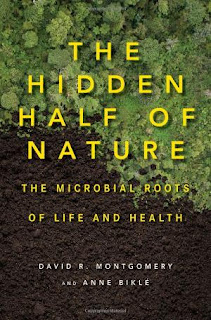The Hidden Half of Nature: The Microbial Roots of Life and Health, by David R. Montgomery and Anne Biklé
 I am conflicted about this book. On one hand, the subject is of terrible relevance and needs to be known by as many people as possible. On the other, the authors are not very good writers: the whole book feels like a big blog post, filled with repetitions, personal opinions and little in the way of hard data. Most of the information in it I already knew, but that's because I am fascinated with the subject. If I didn't know it, I would have probably loved the book.
I am conflicted about this book. On one hand, the subject is of terrible relevance and needs to be known by as many people as possible. On the other, the authors are not very good writers: the whole book feels like a big blog post, filled with repetitions, personal opinions and little in the way of hard data. Most of the information in it I already knew, but that's because I am fascinated with the subject. If I didn't know it, I would have probably loved the book.But what is The Hidden Half of Nature? It's an ecology book. It explains how microbes are the unsung true heroes of plant growth and animal health, including humans. While we cling to narrow views of us versus them and try to kill anything that doesn't agree with us, our lives, our food, our health and our lands depend on the biological health of the microbiome. And it makes a lot of sense. Why would a plant develop a way to absorb nitrogen or break down rock, if all it has to do it exude some sugar and bacteria or fungi are going to do it for it? Why would animals develop complicated organs to break down complex molecules like cellulose when all they have to do is make a space where microscopic creatures live off them and give the animal simple nutrients back? How would it even work to evolve completely independent of the life that you can't see with the naked eye, but outnumbers and outmasses any macroscopic life? We thus learn that most microbes are beneficial and imbalances are much more dangerous than a specific species of a bug.
The book starts with the authors, David R. Montgomery and Anne Biklé, husband and wife, buying a house and dreaming of tending a garden, only to discover that their yard had almost no soil. Bringing a lot of organic matter to decay and be assimilated by microscopic life and then other creatures, from insects and worms to birds and other animals, they are shocked to discover that soil recovers much faster and in inexplicable ways than they were taught. Following the rabbit in its hole, they embark on a journey of discovery on how the microscopic influences every aspect of the macroscopic. It all starts with soil, but then it goes into nutrition and health and it all comes together: the idea that good comes from the health of the entire ecosystem, as all we can actually see with our eyes are big enough to be counted as such, colonized and tended by microscopic creatures that have evolved and cooperated with us to reach an equilibrium.
We become familiarized with the concept of dysbiosis, or dysfunctional symbiosis, and how it affects the nutritional values of food, the quality of the land, our chronic and acute diseases, cancer, allergies. Parallels are drawn: the digestive system as roots, a person as an ecosystem, our gut as a garden. All in all a fascinating and cutting edge subject where the ecology, the systemic health on all levels, is the important driver of our lives.
Yet the style in which the book is written really put me off. I started finding reasons not to read. The first half especially. The book starts by bemoaning the dry style of scientific publications and vows to tell the story in a way that anyone can understand. That means a lot of dramatizations, personal opinions, very little in the way of sourcing the ideas other than a name here and there. And whenever they were getting into something promising, they skirted on the details. I believe that if this book would have moved just a little bit away from the conversational blog-like style towards the Wikipedia format it would have been at least twice as valuable.
Bottom line: a book that most people should read, but I wish it would have been written differently.
0 comments:
Post a Comment